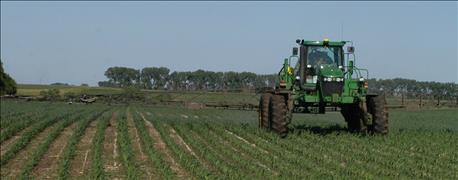May 27, 2016

Paul O. Johnson, South Dakota State University Extension weed specialist, answers questions about how many times you have to spray waterhemp before it is all dead, and whether you really need to stop spraying soybeans when they start to flower.

Corn may have to be sprayed several times to control waterhemp.
How many times do I need to spray waterhemp before it is all dead?
Waterhemp is an annual that comes from seed each year it has the ability to germinate most of the summer and still produce seed. Luckily, the later it gets in the summer the plants will not produce as many viable seeds per plant. The plant seed also has the ability to stay dormant in the soil for several years -- “20 plus” -- and still produce viable plants. The way waterhemp works is that every time there is good rainfall to soak up the surface of the ground and there is not shade cover a new set of seeds can germinate. If you have a pre-emergence product down that is still active then as these seeds germinate they will be killed. If spraying is just done with products that do not have residual as soon as they are sprayed a new flush can come back up.
Here are some options to reduce the amount of flushes that have to be dealt with.
First, start with a clean field whether tillage or a burn-down is used. Then, apply a pre-plant incorporated or pre-emergence to the field. Also, if planting is done in narrower rows the crop will canopy sooner and the ground will be shaded to reduce exposer.
When new flushes appear after the first treatment has went past its residual then, if there still is a significant time till canopy, a second residual product may be needed with this post-emergence contact product to get you to the end of the season and allow you to still be done spraying before the soybeans start to flower.
Do I really need to stop spraying soybeans when they start to flower?
Soybeans will start to flower right after we have the longest day of the year, or for sure by July 1. Once this happens, the soybeans are in the reproductive phase of growth and any stress on the plants can cause flowers to abort or pods drop. Even most glyphosate labels do not allow or recommend treatment after the flowering stage.
Now I will be the first to admit that it may have been done and there were no problems, but that does not mean that there are not times that damage could happen.
Secondly if it states do not apply after flowering on the label, it also could mean that there may be residue left in the plant or in the seed that could contaminate the soybean crop for legal sale. The label is the legal document so following the instructions is important and the law.
You May Also Like




